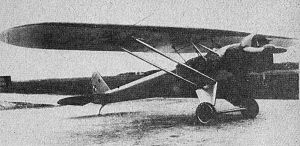- PZL S-1
-
PZL S-1 Role Trainer and liaison aircraft Manufacturer PZL-Mielec First flight 15 November 1945 Retired 1946 Status prototype Primary user Polish Air Force Number built 1 The PZL S-1 was a Polish trainer and liaison aircraft of 1945, which remained a prototype. It was the second aircraft built in Poland after World War II.
Contents
Design and development
The aircraft was designed by engineer Eugeniusz Stankiewicz, being a teacher in the Aviation School in Zamość. Works started in late 1944, soon after liberation of eastern Poland, when central and western parts were still occupied by the Germans. The design of a trainer and liaison plane was approved by the Polish military Aviation Command, and Stankiewicz completed documentation in an aircraft factory PZL-Mielec in Mielec (the factory was destroyed by the Germans and at that time existed as repair works only).
There, a prototype was built, utilizing parts of the Soviet Polikarpov Po-2, like an engine with a propeller, wheels and seats, also a construction of a fuselage was similar to the Po-2. The plane, named S-1 (for Stankiewicz), was very simple. It was flown on 15 November 1945, by the Soviet pilot Piotr Kondratyenko. It was the second Polish-designed plane, that flew after the war (the first was LWD Szpak). Further aircraft were not produced.
The prototype crashed on 14 May 1946 in Warsaw in a bad weather, its pilot, who was Stankiewicz himself, survived.
Description
Wooden construction braced high-wing (parasol wing) monoplane, conventional in layout. Fuselage built of a frame, plywood and cancas covered. Rectangular wing with rounded tips, two-spar. Crew of two, sitting in tandem, in open cockpits with windshields. Fixed conventional landing gear, with a rear skid. Radial engine M-11D in front, with a Townend ring, two-blade wooden propeller (2.4 m diameter). Fuel tanks 126 l.
Specifications
General characteristics
- Crew: 1, instructor
- Capacity: 1, student
- Length: 8.5 m ()
- Wingspan: 13 m ()
- Height: 3.2 m ()
- Wing area: 20 m² (ft²)
- Empty weight: 700 kg ()
- Loaded weight: 950 kg ()
- Powerplant: 1 × Shvetsov M-11D air-cooled 5-cylinder radial engine, 125 hp (92 kW)
Performance
- Maximum speed: 180 km/h
- Stall speed: 55 km/h (34 kt, 39 mph)
- Range: 600 km ()
- Service ceiling: 3,800 m ()
- Rate of climb: 3 m/s ()
- Wing loading: 60 kg/m² ()
See also
- Related development
References
- PZL S-1 at Poser site
- Janusz Babiejczuk, Jerzy Grzegorzewski: Polski przemysł lotniczy 1945-1973, Warsaw 1973 (Polish language)
External links
PZL aircraft PZL - up to 1939
(Państwowe Zakłady Lotnicze)PZL: P.1 · Ł.2 · PZL.3 · PZL.4 · PZL.5 · P.6 · P.7 · P.8 · P.11 · PZL.12 (PZL-H) · PZL.16 · PZL.19 · PZL.23 Karaś · P.24 · PZL.26 · PZL.27 · PZL.30 Żubr · PZL.37 Łoś · PZL.38 Wilk · PZL.39 · PZL.42 · PZL.43 · PZL.44 Wicher · PZL.45 Sokół · PZL.46 Sum · PZL.48 Lampart · PZL.49 Miś · PZL.50 Jastrząb · PZL.53 Jastrząb II · PZL.54 Ryś · PZL.55 · PZL.56 Kania ·
CSS / WSK-Okęcie
/ PZL Warszawa-OkęciePZL: PZL-101 Gawron · PZL-102 Kos · PZL-104 Wilga · PZL-105 Flaming · PZL-106 Kruk · PZL-110 Koliber · PZL-111 Koliber · PZL-112 Junior · PZL-126 Mrówka · PZL-130 Orlik · PZL-230 Skorpion
Other produced: WSK Junak · CSS-10 · CSS-11 · CSS-12 · CSS-13 · PZL Jak-12 · MD-12
WSK-Mielec / WSK PZL-Mielec
/ PZL Mielec (Polskie Zakłady Lotnicze)WSK-Świdnik / WSK PZL-Świdnik / PZL-Świdnik WSK PZL-Krosno KR-03
Szybowcowy Zakład Doświadczalny
/ PZL Bielsko-Biała / Allstar PZL GliderSZD-6 · SZD-7 · SZD-8 · SZD-9 · SZD-10 · SZD-11 · SZD-12 · SZD-13 · SZD-14 · SZD-15 · SZD-16 · SZD-17 · SZD-18 · SZD-20 · SZD-21 · SZD-22 · SZD-23 · SZD-24 · SZD-25 · SZD-26 · SZD-27 · SZD-28 · SZD-29 · SZD-30 · SZD-31 · SZD-32 · SZD-33 · SZD-34 · SZD-35 · SZD-36 · SZD-37 · SZD-38 · SZD-39 · SZD-40 · SZD-41 · SZD-42 · SZD-43 · SZD-45 · SZD-48 · SZD-49 · SZD-50 · SZD-51 · SZD-52 · SZD-54 · SZD-55 · SZD-56 · SZD-59
Lists relating to aviation General Aircraft (manufacturers) · Aircraft engines (manufacturers) · Airlines (defunct) · Airports · Civil authorities · Museums · Registration prefixes · Rotorcraft (manufacturers) · TimelineMilitary Accidents/incidents Records Categories:- Polish military trainer aircraft 1940–1949
- Polish military utility aircraft 1940–1949
Wikimedia Foundation. 2010.

